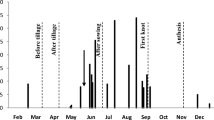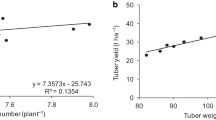Summary
To determine if drip irrigation increases fertilizer requirements and/or the efficiency of utilization compared to furrow irrigation, growth and nitrogen uptake were measured in a four-year experiment comparing surface (SD) and buried (BD) methods of drip irrigation with furrow irrigation (F) of cotton. The soil was a slowly-permeable cracking grey clay (vertisol) at Narrabri, N.S.W Drip-irrigated treatments were maintained at a deficit of 45 mm below the fully-irrigated soil water content, while F was irrigated when the deficit reached about 90 mm. Nitrogen (N) fertilizer was applied weekly with drip irrigation to BD and SD over the first half of the season, and as a conventional single application to F before sowing. Leaf area index (LAI), dry matter and N uptake were influenced more by season than by method of irrigation. LAI during boll filling averaged 2.4 and was 10% greater in BD than in SD and F. Final dry matter averaged 988 g m−2 and was 10% greater in BD and SD than in F. The efficiency of conversion of solar radiation into dry matter averaged 0.55 g MJ−1; lint yield as a fraction of dry matter averaged 0.18; neither parameter was consistently influenced by the method of irrigation. Total N uptake ranged from 97 to 170 kg ha−1 and was influenced by irrigation method in one season only, when it was less in F than in SD and BD. N was often taken up later under drip irrigation than under F: there was up to 40% less N taken up by SD than F in the early flowering stage. The delay was associated with later application of N to BD and SD compared with F, and the application of N to the surface of alternate furrows of SD. Plant factors such as root ageing and competition between roots and bolls, were also implicated. We conclude that all of the N should be applied to drip-irrigated cotton on these soils by mid flowering, and that some of the N should be applied in the soil before sowing.
Similar content being viewed by others
References
Briggs RE, Maatoug MA, Hofmann WC (1983) Flowering, boll set, and yield of drip irrigated cotton in Arizona. In: Brown JM (ed) Proc Beltwide Cotton Prod Res Conf. San Antonio TX. National Cotton Council Memphis TN, p 43
Clarkson DT (1985) Factors affecting mineral nutrient acquisition by plants. Ann Rev Plant Physiol 36:77
Constable GA (1976) Temperature effects on the early field development of cotton. Aust J Exp Agric Anim Husb 16:905
Constable GA (1986) Growth and light receipt by mainstem cotton leaves in relation to plant density in the field. Agric For Meteorol 37:279
Constable GA, Hearn AB (1981) Irrigation for crops in a sub-humid environment. VI. Effect of irrigation and nitrogen fertilizer on growth, yield and quality of cotton. Irrig Sci 3:17
Constable GA, Hodgson AS (1990) A comparison of drip and furrow irrigated cotton on a cracking clay soil. 3. Yield and quality of four cultivars. Irrig Sci 11:149–153
Constable GA, Rochester IJ (1988) N application to cotton on clay soil: timing and soil testing. Agron J 80:498
Coulson CL (1985) Radiant energy conversion in three cultivars of Phaseolus vulgaris. Agric For Meteorol 35:21
Crowther F (1934) Studies in growth analysis of the cotton plant under irrigation in the Sudan. I. The effect of different combinations of nitrogen applications and water-supply. Ann Bot 68:877
Cushman JH (1984) Numerical study of some age-dependent parameters in root nutrient uptake. Plant Soil 79:123
Daniells IG (1989) Degradation and restoration of soil structure in a cracking grey clay used for cotton production. Aust J Soil Res 27:455
Eaton FM, Joham HE (1944) Sugar movement to the roots, mineral uptake and the growth cycle of the cotton plant. Plant Physiol 19:507
Halevy J, Kramer O (1986) Nitrogen fertilizer management of cotton grown under drip irrigation in a grumosol. Irrig Sci 7:63
Hearn AB (1975) Response of cotton to nitrogen and water in a tropical environment. I. Frequency of watering and method of application of nitrogen. J Agric Sci UK 84:407
Hearn AB (1981) Cotton nutrition. Field Crop Abs 34:11
Hearn AB (1986) Effect of preceding crop on the nitrogen requirements of irrigated cotton (Gossyprium hirsutum L.) on a vertisol. Field Crops Res 13:159
Hearn AB, Constable GA (1984) Irrigation for crops in a subhumid environment VII. Evaluation of irrigation strategies for cotton. Irrig Sci 5:75
Hearn AB, Ives PM, Room PM, Thomson NJ, Wilson LT (1981) Computer-based cotton pest management in Australia. Field Crops Res 4:321
Hodgson AS (1982) The effects of duration, timing and chemical amelioration of short-term waterlogging during furrow irrigation of cotton in a cracking grey clay. Aust J Agric Res 33:1019
Hodgson AS, Chan KY (1987) Field calibration of a neutron moisture meter in a cracking grey clay. Irrig Sci 8:233
Hodgson AS, MacLeod DA (1987) Effects of foliar applied nitrogen fertilizer on cotton waterlogged in a cracking grey clay. Aust J Agric Res 38:681
Hodgson AS, MacLeod DA (1988) Seasonal and soil fertility effects on the response of waterlogged cotton to foliar-applied nitrogen fertilizer. Agron J 80:259
Hodgson AS, Constable GA, Duddy GR, Daniels IG (1990) A comparison of drip and furrow irrigated cotton on clay soil. 2. Water use efficiency, waterlogging, root distribution and soil structure. Irrig Sci 11:143–148
Howell TA, Bucks DA, Chesness JL (1981) Advances in trickle irrigation. In: Irrigation, challenges of the 80's. American Society of Agricultural Engineers, St Joseph, Michigan, p 69–94
Imsande J, Edwards DG (1988) Decreased rates of nitrate uptake during pod fill by cowpea, green gram, and soybean. Agron J 80:789
Mason WK, Constable GA, Smith RCG (1980) Irrigation for crops in a sub-humid environment. II. The water requirements of soybeans. Irrig Sci 2:13
Muchow RC, Charles-Edwards DA (1982) An analysis of the growth of much beans at a range of plant densities in tropical Australia. I. Dry matter production. Aust J Agric Res 33:41
Muchow RC, Coates DB (1986) An analysis of the environmental limitations to yield of irrigated grain sorghum during the dry season in tropical Australia using radiation interception model. Aust J Agric Res 37:135
Nir D (1981) Drip irrigation. In: Finkel HJ (ed) CRC Handbook of irrigation technology, Vol 1. CRC Press, Boca Raton, Florida, pp 247–298
Northcote KH, Hubble GD, Isbell RF, Thompson CH, Bettanay E (1975) A description of Australian soils. CSIRO, Glen Osmond
Pennington DA, Briggs RE (1983) Nitrogen fertility and soil salinity in drip irrigated cotton. In: Brown JM (ed) Proc Beltwide Cotton Prod Res Conf. San Antonio TX. National Cotton Council Memphis TN, p 40
Radin JW, Mauney JR, Kerridge PC (1989) Water uptake by cotton roots during fruit filling in relation to irrigation frequency. Crop Sci 29:1000
Author information
Authors and Affiliations
Rights and permissions
About this article
Cite this article
Constable, G.A., Rochester, I.J. & Hodgson, A.S. A comparison of drip and furrow irrigated cotton on a cracking clay soil. Irrig Sci 11, 137–142 (1990). https://doi.org/10.1007/BF00189450
Received:
Issue Date:
DOI: https://doi.org/10.1007/BF00189450




